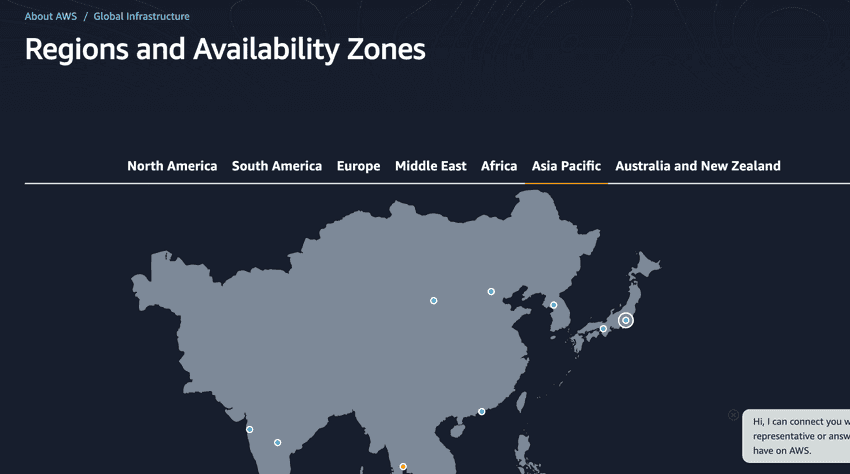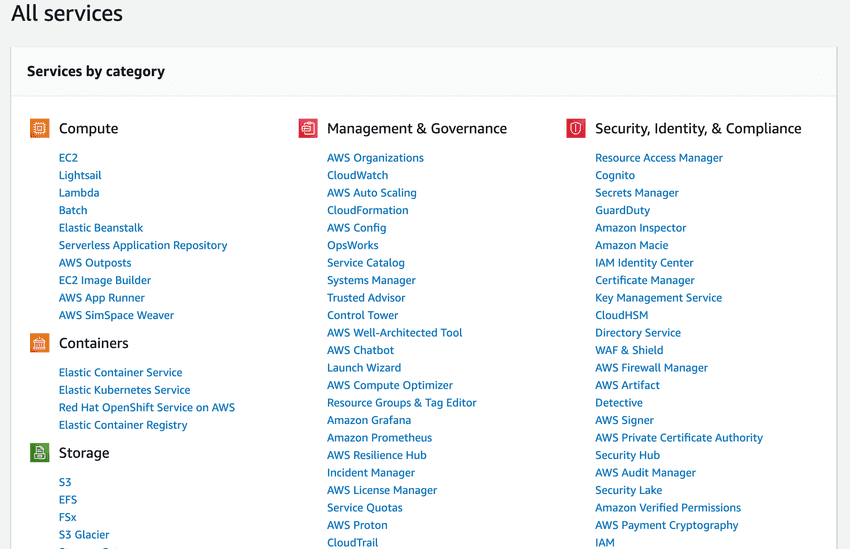Breakdown of What We Will Learn
- AWS Global Infrastructure
- Regions
- Availability Zones
- Data Centers
- Edge Locations
- The AWS Management Console
AWS Global Infrastructure
The AWS Global Infrastructure is split between Regions and Availability Zones.
At the time I'm writing this blog, there are 33 regions and 105 availability zones.
The number of regions and availability zones will change over time, and we won't be tested for the exact number in the exam.
What is an Availability Zone?
You can think of an Availability Zone as a Data Center.
If you haven't worked in tech before, or if you've never been to a data center, you may wonder what a data center is.
What is a Data Center?
A data center is a building that's filled with servers. That's all it is. It's a building with rows and rows of servers. They're in data halls, and you have multiple data halls per data center.
An Availability Zone may have Multiple Data Centers. Since these Data Centers are close together, they are counted as 1 Availability Zone.
So it doesn't necessarily mean it's just one data center; it's always going to be multiple data centers, but they will be close enough together to be grouped into one Availability Zone.
What is a Region?
A region is simply a location. So it can be Mumbai, Cape Town, London, etc. It is a physical location.
- A Region is a geographical area.
- Each region consists of 3 (or more) Availability Zones. (Earlier it was 2 (or more)).
This is how the Region looks like:
Regions and Availability Zones
Now, you may wonder what an Edge Location is.
What is an Edge Location?
Edge Locations are endpoints for AWS that are used for caching content.
- Typically, this consists of CloudFront, which is Amazon's Content Delivery Network (CDN) Service. We will learn about this in upcoming blogs.
- There are many more Edge Locations than Regions.
- Currently, at the time of writing this, there are 400 edge locations around the world.
Tips for Exam: There are many more Edge Locations than there are Regions.
There are different service types that sit on top of AWS Global Infrastructure.
| Service Type | AWS Services |
|---|---|
| Compute | EC2, Lambda, Elastic Beanstalk, ECS, EKS, Fargate |
| Storage | S3, EFS, FSx, Glacier, Storage Gateway |
| Database | RDS, DynamoDB, Redshift, Aurora, DocumentDB, Neptune, QLDB |
| Networking & Content | VPC, CloudFront, Route 53, API Gateway, Direct Connect, Global Accelerator, Transit Gateway |
| Security, Identity, & Compliance | IAM, KMS, CloudHSM, GuardDuty, Macie, Inspector, Cognito, Artifact, Security Hub |
| Management & Governance | CloudWatch, CloudTrail, Config, Systems Manager, Trusted Advisor, Service Catalog, Control Tower |
| Developer Tools | CodeCommit, CodeBuild, CodeDeploy, CodePipeline, Cloud9, X-Ray, CodeStar |
| Machine Learning | SageMaker, Comprehend, Rekognition, Lex, Polly, Translate, Transcribe, Personalize, DeepLens |
| Analytics | Athena, EMR, CloudSearch, Elasticsearch Service, Kinesis, QuickSight, Data Pipeline |
| Migration & Transfer | DMS, Snowball, Snowmobile, Transfer Family, Migration Hub, Application Discovery Service |
| Customer Engagement | Connect, Pinpoint, Simple Email Service (SES) |
| Business Applications | WorkSpaces, AppStream 2.0, WorkDocs, WorkMail, Chime, Alexa for Business |
| Internet of Things (IoT) | IoT Core, IoT Greengrass, IoT Analytics, IoT Button, IoT Device Management, IoT Events |
| Game Tech | GameLift, Lumberyard |
| Media Services | Elastic Transcoder, MediaConvert, MediaLive, MediaPackage, MediaStore, MediaTailor |
| Satellite | Ground Station |
Well, these are a lot of services. I will not go through each one of them, but we will explore all those services which are essential for the AWS Certified Solutions Architect Associate (SAA-C03) Exam.
Underneath each of these Service Types, we have individual services like EC2, Lambda, CloudWatch, etc.
The AWS Management Console
Visit Console Home to explore the different Service Types and Services.
Don't get overwhelmed by looking at all these different services. From the SAA-C03 Exam point of view, we only need to know a few of these services to pass the exam. So you'll never know all services inside out with AWS.
But these are the few Service Types and Services that we need to know in order to pass our exam.
| Service Type | Key AWS Services for SAA-C03 Exam |
|---|---|
| Compute | EC2, Lambda, Elastic Beanstalk, ECS, EKS, Fargate |
| Storage | S3, EFS, Glacier, Storage Gateway |
| Database | RDS, DynamoDB, Aurora, Redshift |
| Networking & Content Delivery | VPC, CloudFront, Route 53, API Gateway, Direct Connect |
| Security, Identity, & Compliance | IAM, KMS, CloudTrail, Shield, WAF, Cognito, Artifact, GuardDuty |
| Management & Governance | CloudWatch, CloudFormation, CloudTrail, Config, Systems Manager, Trusted Advisor |
| Migration & Transfer | DMS, Snowball, Migration Hub, Transfer Family |
| Analytics | Athena, CloudSearch, Elasticsearch Service, Kinesis, QuickSight |
| Developer Tools | CodeCommit, CodeBuild, CodeDeploy, CodePipeline |
| Machine Learning | SageMaker |
| Cost Management | Cost Explorer, AWS Budgets, Cost and Usage Reports |
- Compute: We will focus on understanding how to provision, deploy, and manage EC2 instances, serverless applications using Lambda, and containerized applications using ECS and EKS.
- Storage: We will learn the different storage options, their use cases, and how to secure them.
- Database: We will understand the managed database services offered by AWS, including relational databases (RDS, Aurora) and NoSQL databases (DynamoDB).
- Networking: We will familiarize ourselves with VPC configurations, content delivery using CloudFront, and DNS management with Route 53.
- Security: Emphasis on IAM roles and policies, key management using KMS, monitoring with CloudTrail, and protection using Shield and WAF.
- Management & Governance: We will learn about monitoring and logging (CloudWatch, CloudTrail), infrastructure as code (CloudFormation), and resource management (Config, Systems Manager).
- Migration: We will understand the tools and services available for migrating data and applications to AWS.
- Analytics: We will learn the basics of analytics services like Athena and Kinesis for real-time data processing.
- Developer Tools: We will be familiar with CI/CD tools and processes for automating code deployment.
- Machine Learning: We will grasp a basic understanding of SageMaker for building, training, and deploying ML models.
- Cost Management: Learn how to manage and optimize AWS costs using Cost Explorer and Budgets.
Tips for AWS Building Blocks:
- A Region is a physical location in the world that consists of 3 (or more) Availability Zones (AZs).
- An AZ is one or more discrete data centers—each one with redundant power, networking, and connectivity—housed in separate facilities.
- Edge Locations are endpoints for AWS that are used for caching content. Typically, it consists of CloudFront, which is AWS's CDN.
Learn More
- A Practical Guide to Data Collection with OpenTelemetry, Prometheus, and Grafana
- Beginner's Guide to HTTP Methods and Status Codes
- Flask and SQLAlchemy: Better Data Management
Please let me know if there's anything else I can add or if there's any way to improve the post. Also, leave a comment if you have any feedback or suggestions.




Discussions